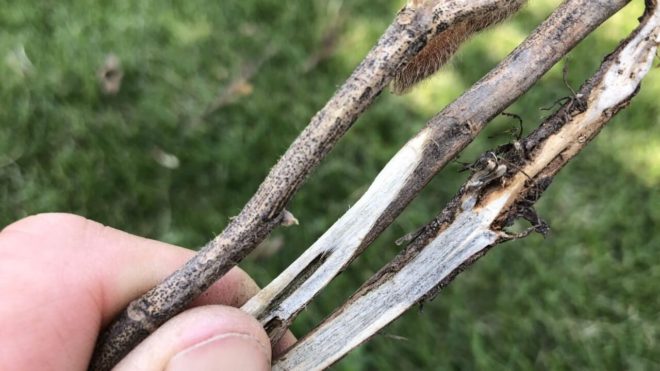Charcoal rot is a fairly common disease in dry portions of the U.S. where soybeans are grown. Most years, it’s easy to find charcoal rot in areas of Missouri and Kansas; however, the disease is typically challenging to find in geographies further to the east and north.
In recent years, this disease has become more prevalent in some areas as drier, warmer conditions have become more common in regions that typically don’t experience drought. It’s safe to assume that the drier, warmer conditions provide a more favorable environment for charcoal rot to thrive.
Charcoal rot is caused by the soil-borne fungus Macrophomina phaseolina. This fungus can infect many crops that are grown across the U.S. It is also able to survive and reproduce on many weed species that are common throughout the country. This wide range of hosts may also contribute to the disease’s ability to spread into new geographies.
The charcoal rot fungus overwinters in soil and plant residue in a fungal structure called a microsclerotia. These small, rigid, black structures support disease survivability in the soil environment. As soybean roots encounter microsclerotia in the soil, the microsclerotia germinate and infect the soybean root. Once infection occurs, the fungus spreads throughout the root mass and lower stem of the plant. The disease spreads much more rapidly through the plant as they approach maturity, clogging the vascular system. This halts the plant’s ability to uptake and utilize water effectively, causing wilt. After plant death, the leaves remain attached to the plant.
We typically don’t start receiving calls about charcoal rot until just before or during harvest. In most of the cases I have seen, the farmer found portions of fields or whole fields that yielded significantly less than other fields. Upon investigation, it’s common to find a charcoal appearance in the stems that is common with this disease. The areas that are typically most affected include hillsides or terrace tops, or sandy, compacted areas. The common link between all of these areas is that they suffer from increased drought stress. I have seen charcoal rot issues following wetter conditions, but most of the time, we find it in drier years.
A multi-faceted approach is required for managing charcoal rot. Genetic resistance varies by variety. Combining genetic resistance with several cultural practices can help minimize this disease’s impact. Most cultural practices center around reducing moisture stress to the soybean crop. Irrigation, reduced tillage, and lower seeding rates can help. Crop rotation can be challenging due to the number of crops that act as hosts for charcoal rot, except wheat, which is a poor host.
Charcoal rot can be a new disease for some farmers, especially in areas through the north and eastern parts of the U.S. If you notice problems in your soybean fields that you can’t explain, contact your local Beck’s dealer so we can assist in diagnosing the problem.
~ Scott Dickey, CCA – Field Agronomist

